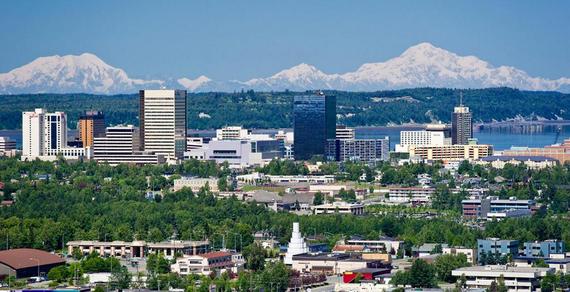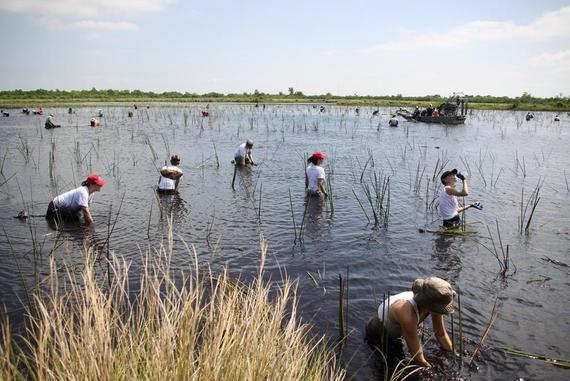In our most recent column, we examined New York as we looked at the surprisingly large amount of natural lands in the park systems of the nation's largest cities.
But New York is not alone, as the recent Center for City Park Excellence "City Park Facts" report makes clear.
In many cities, the preponderance of natural areas is due to "the idiosyncrasies of city boundaries" according to the CCPE, but also because many cities have within their boundaries large federal or state parks, or natural areas. For example, Anchorage, Alaska leads all cities by a wide margin. Its astonishing 501,785 acres of parkland include just 2,400 acres of designed parks, and the vast majority of the rest is in the Chugach State Park, with 490,125 acres within the Anchorage city limits.

View of Anchorage and its natural surroundings. Image courtesy of anchorage.net.
Spacious natural parks also dominate in cities with large populations as well as in those not as densely populated. Of the 36,113 acres of parkland in Los Angeles, more than 26,000 are natural, with the state managing more than 10,000 acres, and the Mountains Recreation and Conservation Authority managing almost 6,000 acres. Phoenix, Arizona also has a huge park system, mostly city-owned, and 43,610 acres are natural, with 5,654 acres designed. In nearby Scottsdale, Arizona's nearly 29,000 acres of parks, a scant 974 are designed. In New Orleans, Louisiana more than 24,000 of the total 28,432 acres of parks are in the Bayou Sauvage National Wildlife Refuge.
So with all of this natural land, what are the best ways for cities to protect and even expand these areas? Some face threats that may include inappropriate development (such as utility rights of way), lack of funding for maintenance and security, and the effects of climate change.
Is there consensus among city leaders, or even among environmental managers, for how best to take care of the resource? For example, in many cities, there have been efforts to restore natural areas through the careful eradication of non-native, exotic species of plants, and even of animals. But that is an expensive proposition, with no certainty of a desired outcome, and some professionals, such as Peter del Tredici, suggest that we should respect the tenacity and success of certain invasives and not try to fight an ultimately losing battle against them.

Visitors to the McDowell Sonoran Preserve in Scottsdale, Arizona. Image courtesy of Take a Hike Arizona.
What are the challenges confronting natural areas in cities and the benefits they provide? How can cities best address these challenges, and who are their potential allies?
First, the impetus to protect and enhance urban natural areas must start locally. In a number of cities, municipal and county government and nonprofit organizations have come together in productive partnerships. The Green Seattle Partnership provides a sophisticated stewardship model for urban woodlands. In Portland, the Intertwine brings together a variety of levels of government and the non-profit sector to address the varied needs of natural spaces and the connective tissue of greenways. The Chicago Wilderness Alliance links together public and private entities with a focus on the prairie ecosystem.
But a stronger partnership between the three prominent levels of government may also be the key to success. In New York City, the Natural Resources Group of the Parks Department is partnering with the U.S. Forest Service in the operation of an "Urban Field Station," a jointly run laboratory where city, state, federal and academic researchers and practitioners are studying the impact of natural areas and trees on the environmental health of cities. The Million Trees NYC project, that has led to the planting (so far) of nearly 850,000 trees, is now the focus of research projects thorough the Urban Field Station. It is accepted that trees and woodlands play an important role in cleaning the air, storing carbon, mitigating the urban heat island effect, and processing storm water, but how much of a role do they play relative to other design features? Which trees function best in the difficult urban environment, and what is the mortality rate of small whips planted in old landfills compared to large balled-and-burlapped trees planted in sidewalk pits?
Part of the funding for the research, and for base-level assessments of the natural areas of NYC is coming from a major public-private partnership focused on helping protect and manage the resources, known as the Natural Areas Conservancy, which in just a few years has already raised over $5 million in donations from private funders. Also in New York City, a conservancy has been formed to partner with both the National Park Service and the NYC Parks Department on caring for and programming the 10,000 acres of mostly natural parklands of Jamaica Bay, and a research institute focused on the damaged ecosystem of the bay has recently been created.
But the biggest lift may be the one of changing attitudes. Too many elected officials still look at large natural areas and see them as "empty" or "undeveloped," envisioning active recreation facilities, roads, container ports or real estate developments. In coastal cities, at least, drastic weather events such as Hurricane Katrina and SuperStorm Sandy have shown the perils of building anything in flood zones. But as cities grow and feel pressure to create housing and economic development, will we forget the cruel lessons of the recent past?

National Wildlife Federation volunteers work at Bayou Sauvage National Wildlife Refuge. Image and caption courtesy of the National Wildlife Federation.
Particularly in cities affected by extreme weather events, we have seen an evolution and new appreciation for the ecosystems services value of natural areas, and even the value of creating green infrastructure to capture storm water and mitigate storm surge, with the attendant layers of value as parks and habitat. And there may be additional, less urgent, but equally interesting challenges.
There are a number of metrics that have been developed for calculating the value of trees on city streets and in landscape designs, but not necessarily for urban forests. Can we develop metrics for the value of large urban natural areas? How much carbon dioxide can be processed by one tree? What are the optimum species and sizes? What is the rate of return of a large wooded area? Does size matter, or is it density and species composition? The groundbreaking work of Richard T.T. Forman in landscape ecology offers ways to predict the soil's carbon storage potential in different types of forests or other landscapes, based on such factors as types of plants and rainfall data. Are all wetlands generally helpful in storm surge mitigation, or must they be of a certain magnitude? Can we develop metrics that would suggest an ideal amount of tidal wetland or number of trees per person for an environmentally healthy city?
Three decades ago, forestry school graduates and ecologists were looked at as batty to practice their trades in or focus research on cities -- surely, no real "nature" was taking place there. But as people around the world and in the U.S. (83 percent at last count) live in cities, and as we come to understand the extraordinary value of natural areas to cities, the cutting edge research and practice of natural area protection and management will increasingly take place in urban areas. Elected officials, public sector managers, nonprofit and academic partners, and citizens can help to effect a sea change in how our urban natural areas are viewed, appreciated and treated going forward.
A version of this blog originally appeared on The Nature of Cities.
